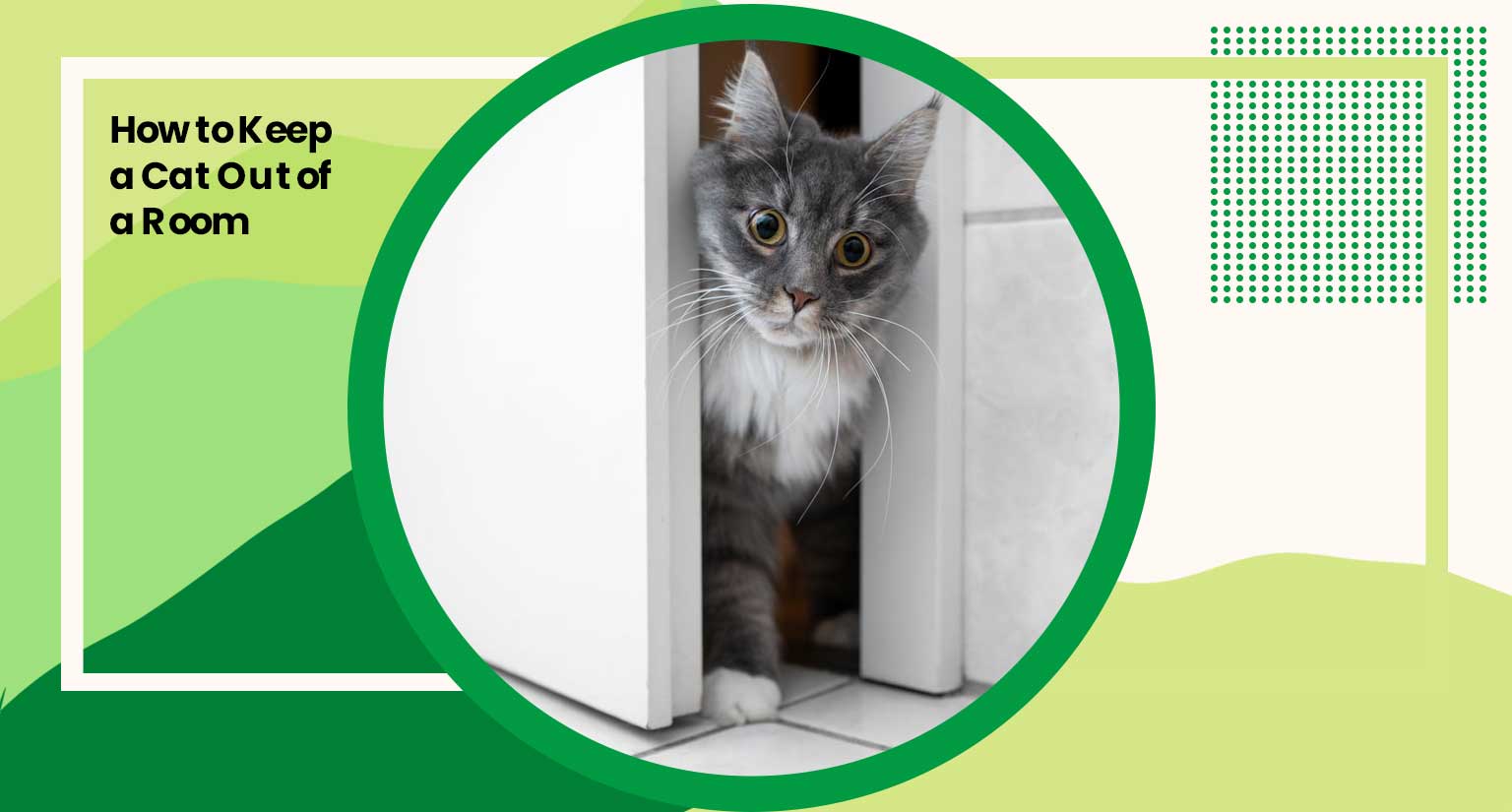How to Keep a Cat out of a Room?
Are you wondering how to keep a cat out of a room? If you’re a cat owner, you’ve likely encountered the occasional need to restrict your feline friend’s access to certain areas of your home.
In this guide, we’ll explore practical and cat-friendly strategies that allow you to maintain harmony in your home while keeping your kitty comfortable. Let’s delve into the world of cat-proofing your space.
How to Keep a Cat Out of a Room Without Closing the Door?
Keeping your cat out of a room without resorting to shutting the door, I understand the struggle. Cats are curious creatures, and they often don’t take kindly to being restricted.
Luckily, there are some clever and cat-friendly strategies you can employ. Let’s dive into the details of how to accomplish this?
Create a Cat-Proof Barrier
To keep your cat out of a particular room, consider installing a cat-proof barrier. There are various options available, such as cat gates or baby gates, which are designed to prevent your feline friend from entering without causing harm. Place them strategically to create a physical boundary that keeps your cat away from the forbidden space.
Use Double-Sided Tape
Cats are known for their dislike of sticky textures. Applying double-sided tape to the bottom of the door or the floor near the entrance can deter your cat from crossing that boundary. The unpleasant sensation on their paws will encourage them to turn back, leaving the room unexplored.
Employ a Scent Deterrent
Cats have a keen sense of smell, and there are scents they find repugnant. Consider using cat-safe scent deterrents like citrus, eucalyptus, or lavender around the entrance to the room you want to protect. Cats tend to avoid these scents, making it less appealing for them to enter.
Provide an Attractive Distraction
Sometimes, cats are just looking for something to keep them entertained. Set up a special area with toys, scratching posts, or a cozy bed near the entrance of the room. This will divert their attention and satisfy their curiosity without them needing to enter the off-limits space.
Train with Positive Reinforcement
Positive reinforcement can go a long way in teaching your cat to stay out of certain rooms. Reward them with treats and affection when they obey your command to stay away from the restricted area. Be patient and consistent with your training.
Invest in an Automated Pet Deterrent
Technology can also come to your aid. Automated pet deterrents, like motion-activated air sprayers or ultrasonic devices, can discourage your cat from entering specific rooms. These devices provide a harmless but effective way to maintain boundaries.
Is It Possible to Teach a Cat to Avoid a Room?
Yes, it is possible to teach a cat to avoid a room. With positive reinforcement, consistent training, and a cat-friendly approach, you can establish boundaries that both you and your feline friend can live with harmoniously.
Teaching a cat to avoid a specific room is a question that many cat owners ponder. The good news is that, while cats have a reputation for independence, it is indeed possible to train them to steer clear of certain areas.
Cats are intelligent animals, and with the right approach, patience, and consistency, you can successfully teach them to respect your boundaries.
Power of Positive Reinforcement
One of the most effective methods to train your cat is through positive reinforcement. Whenever your cat behaves as desired, such as staying out of a particular room, reward them with treats, praise, and affection. Cats respond well to positive feedback, and this can help reinforce the desired behavior.
Creating Unattractive Associations
Cats are sensitive to their environment and experiences. You can make a room less appealing to them by creating negative associations.
For example, if your cat dislikes the scent of citrus, place citrus-scented items near the entrance. Cats may avoid the room to escape the unpleasant smell.
Use of Physical Barriers
Physical barriers like baby gates or cat gates can be an effective way to establish boundaries. They create a visual and physical obstacle that cats typically respect.
Over time, your cat may come to associate the presence of these barriers with the room they should avoid.
How Do You Keep Pets Out of Your Room?
Keeping pets out of your room, whether it’s a dog, cat, or another furry friend, can be essential for various reasons, such as maintaining cleanliness or creating a pet-free space for your comfort. Here are some effective strategies to keep your pets out of your room:
Use Pet Gates
Pet gates, also known as baby gates, are versatile tools for creating physical barriers. They allow you to control your pet’s access to certain areas of your home, including your room.
Establish a Pet-Free Zone
Designate specific areas in your home as pet-free zones, and train your pets to respect these boundaries. Consistency and positive reinforcement are key to success.
Apply Scent Deterrents
Pets are sensitive to scents. Apply pet-safe scent deterrents near your room’s entrance to make the area less appealing to your pets. Common scents that pets often dislike include citrus, eucalyptus, and lavender.
Provide Alternative Entertainment
Ensure your pets have their own designated area with toys, scratching posts, and a comfortable bed. This will keep them engaged and entertained, reducing their interest in your room.
Close the Door
The most straightforward method is to keep your door closed. If your pets can’t push the door open, this can be an effective way to maintain the privacy of your room.
Use Repellent Mats
Repellent mats or strips are designed to create an uncomfortable surface for pets to walk on. Placing these near your room’s entrance can discourage them from entering.
How Do You Teach a Cat No?
Teaching a cat to understand and respond to the command “no” requires patience, consistency, and a cat-friendly approach. Cats are unique creatures, and their responses to training methods may vary.
Here’s a step-by-step guide on how to teach a cat “no”:
Timing Is Crucial
Cats have short attention spans, so it’s essential to catch them in the act of undesirable behavior. This way, you can provide immediate feedback.
Use a Clear and Firm Voice
When you catch your cat engaging in unwanted behavior, say “no” in a clear and firm voice. Your tone should be authoritative but not frightening. The goal is to get their attention without causing fear.
Offer an Alternative
Once you’ve said “no,” immediately redirect your cat’s attention to a more acceptable activity. For example, if they are scratching the furniture, gently move them to a scratching post and encourage them to use it.
Consistency is crucial in teaching a cat “no.” Everyone in your household should use the same command and follow the same rules. Inconsistency can confuse your cat.
Positive Reinforcement
While “no” is important, positive reinforcement is equally vital. Reward your cat with treats, praise, or affection when they respond to “no” and engage in the desired behavior. This helps reinforce the correct response.
Avoid Punishments
Never resort to physical punishments or yelling. Cats do not respond well to negative reinforcement, and it can damage the trust between you and your pet.
Teaching a cat “no” is a process that requires time and understanding. By using a clear and firm voice, offering alternatives, and reinforcing positive behaviors, you can successfully communicate boundaries and encourage your cat to follow your commands.
Frequently asked questions (FAQs)
1.Why would I want to keep my cat out of a room?
There are various reasons to keep a cat out of a room, including protecting sensitive items, preventing potential hazards, or creating a pet-free space for allergy sufferers.
2.Can I train my cat to avoid a specific room?
Yes, you can train your cat to avoid a specific room through positive reinforcement, consistency, and patience. Cats can learn to respect boundaries with the right approach.
3.How can I balance keeping my cat out of a room and maintaining their well-being?
To balance both aspects, ensure your cat has access to enriching and comfortable spaces within your home, along with positive reinforcement and affection to compensate for restricted areas.
4.Can I keep a cat out of a room without closing the door completely?
Yes, you can partially close the door or use alternative methods like cat gates, double-sided tape, or scent deterrents to create a barrier without fully shutting the door.
5.How long does it usually take to train a cat to stay out of a room?
The time it takes to train a cat varies depending on the cat’s personality and the training method used. It may take weeks to months to establish consistent behavior.
6.Is it possible to teach an older cat new boundaries?
Yes, it’s possible to teach older cats new boundaries, although it may take more time and patience compared to training a kitten. Positive reinforcement methods can still be effective.







